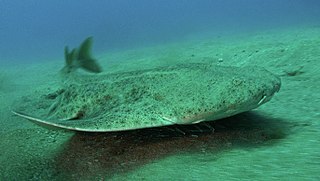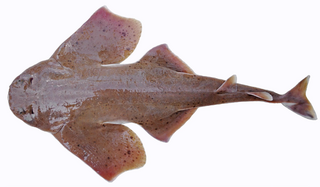
The angelsharks are a group of sharks in the genus Squatina of the family Squatinidae. They commonly inhabit sandy seabeds close to 150 m (490 ft) in depth. Many species are now classified as critically endangered by the International Union for Conservation of Nature. Once common over large areas of the Northeast Atlantic from Norway, Sweden, Morocco and the Canary Islands, to the Mediterranean and Black Seas, fishing pressure has resulted in significant population decline.

The bramble shark is one of the two species of sharks in the family Echinorhinidae. Aside from the eastern Pacific Ocean, it is found in tropical and temperate waters worldwide. This rarely encountered shark swims close to the bottom of the seafloor, typically at depths of 400–900 m (1,300–3,000 ft), though it may enter much shallower water. The bramble shark has a stout body with two small dorsal fins positioned far back and no anal fin. It can be readily identified by the large, thorn-like dermal denticles scattered over its body, some of which may be fused together. It is purplish brown or black in color and grows up to 3.1 m (10 ft) long.
The narrownose chimaera is a longnose chimaera of the family Rhinochimaeridae, the longnose chimaeras, consisting of eight species belonging three genera. This species is found in temperate seas worldwide, at depths between 200 and 3,100 m. Its length is between 1.0 and 1.5 m, including a long, tapering snout and a long, filamentous tail.

The sand devil or Atlantic angel shark is a species of angelshark, family Squatinidae, native to the northwestern Atlantic Ocean. It occurs off the eastern United States, in the northern Gulf of Mexico, and possibly in parts of the Caribbean Sea. This bottom-dwelling shark is found in shallow inshore waters in summer and fall, and deep offshore waters in winter and spring. The sand devil's flattened body and enlarged pectoral and pelvic fins give it a ray-like appearance. There is a band of enlarged thorns running along the middle of its back. It is gray or brown in color, with scattered small dark spots. This species reaches 1.2–1.5 m (3.9–4.9 ft) in length.

The sawback angelshark is an angelshark of the family Squatinidae It is one of rarest species of sharks known to date, and one of the three species of angelsharks that inhabits the Mediterranean. The Sawback angelshark lives in sandy and muddy bottoms of the ocean at depths of 30-500m.

The Pacific angelshark is a species of angelshark, family Squatinidae, found in the eastern Pacific Ocean from Alaska to the Gulf of California, and from Ecuador to Chile, although those in the Gulf of California and southeastern Pacific may in fact be separate species. The Pacific angelshark inhabits shallow, coastal waters on sandy flats, usually near rocky reefs, kelp forests, or other underwater features. This species resembles other angel sharks in appearance, with a flattened body and greatly enlarged pectoral and pelvic fins. Characteristic features of this shark include a pair of cone-shaped barbels on its snout, angular pectoral fins, and a brown or gray dorsal coloration with many small dark markings. It attains a maximum length of 1.5 m (4.9 ft).

The Taiwan angelshark is an angelshark in the family Squatinidae. The Taiwan angelshark is one of four species of Squatina in the waters around Taiwan and Japan. It is a demersal, ray-like shark that grows to 1–2 meters in length.

The Japanese angelshark is a species of angelshark, family Squatinidae, found in the northwestern Pacific Ocean off China, Japan, and Korea. It is a bottom-dwelling shark found in sandy habitats down to 300 m (980 ft) deep. This species has the flattened shape with wing-like pectoral and pelvic fins typical of its family, and grows to 1.5 m (4.9 ft) or more in length. Its two dorsal fins are placed behind the pelvic fins, and a row of large thorns occurs along its dorsal midline. Its upper surface is cryptically patterned, with numerous squarish dark spots on a brown background.

Squatina squatina, the angelshark or monkfish, is a species of shark in the family Squatinidae, that were once widespread in the coastal waters of the northeastern Atlantic Ocean. Well-adapted for camouflaging itself on the sea floor, the angelshark has a flattened form with enlarged pectoral and pelvic fins, giving it a superficial resemblance to a ray. This species can be identified by its broad and stout body, conical barbels, thornless back, and grayish or brownish dorsal coloration with a pattern of numerous small light and dark markings. It measures up to 2.4 m (7.9 ft) long.

The ornate angelshark is an angelshark of the family Squatinidae endemic to southern Australia between latitudes 30°S and 35°S, at depths of 130–400 m (430–1,310 ft). It can reach lengths of up to 1.4 m (4.6 ft). Females tend to have a TL at 1150–1250 mm, while males range from a TL of 810–910 mm at sexual maturity. Reproduction is ovoviviparous, with two to nine pups per litter.

The pelagic stingray is a species of stingray in the family Dasyatidae, and the sole member of its genus. It is characterized by the wedge-like shape of its pectoral fin disc, which is much wider than long, as well as by the pointed teeth in both sexes, whip-like tail with extremely long tail spine, and uniform violet to blue-green coloration. It generally reaches 59 cm (23 in) in width. The pelagic stingray has a worldwide distribution in waters warmer than 19 °C (66 °F), and migrates seasonally to spend the summer closer to the continental shelf and at higher latitudes. The only stingray that almost exclusively inhabits the open ocean, this species is typically found in surface waters down to a depth of 100 m (330 ft). As a consequence of its midwater habits, its swimming style has evolved to feature more of a flapping motion of the pectoral fins, as opposed to the disc margin undulations used by other, bottom-dwelling stingrays.

The spiny butterfly ray or giant butterfly ray is a species of butterfly ray, family Gymnuridae, native to the shallow coastal waters of the Atlantic Ocean. A large ray that can measure over 2 m across, it may be distinguished from the sympatric smooth butterfly ray by the spine at the base of its tail and by a small tentacular structure on the margin of each spiracle. Slow-reproducing and valued for its meat, in recent decades its population has experienced a decline of over 30%, and it has become Critically Endangered in certain parts of its range.

The Indonesian angelshark is a rare species of angelshark, family Squatinidae, known only from a few specimens collected from fish landing sites in southern Indonesia. It is thought to inhabit the deep waters of the continental slope. Reaching at least 1.34 m (4.4 ft) long, this species has a flattened, ray-like shape and a well-developed tail and caudal fin. It is characterized by the absences of fringes on its nasal barbels and thorns down the midline of its back, as well as by its relatively plain grayish-brown dorsal coloration with dark saddles beneath the dorsal fin bases and a black leading margin on the underside of the pectoral fins. The International Union for Conservation of Nature (IUCN) has classified it as Critically Endangered due to significant fishing pressure.

David's angelshark is a species of angelshark newly described in 2016. It can grow up to around 75 cm in length and is coloured greyish to brownish yellow. Male specimen are dark spotted, while females have abundant whitish spots. David's angelshark inhabits the northern coast of South America from Colombia to Suriname and is currently known from a depth between 100 and 150 m.
The hidden angelshark(Squatina occulta) is a species of angelshark that was named by Carolus Maria Vooren and Kleber Grübel da Silva in 1991. It inhabits the Atlantic coastline of South America from southern Brazil to Argentina. Hidden angel sharks grow up to 124 cm in length and are ovoviviparous, meaning the embryos develop inside eggs that remain inside the mother's body until they are ready to hatch.

Squatina mapama is a species of angelshark found in the Caribbean. It was described by Douglas J. Long, David A. Ebert, Jose Tavera, Arturo Acero Pizarro, and David Ross Robertson in December 2021.

Rajella fyllae is a species of skate in the family Rajidae.
















